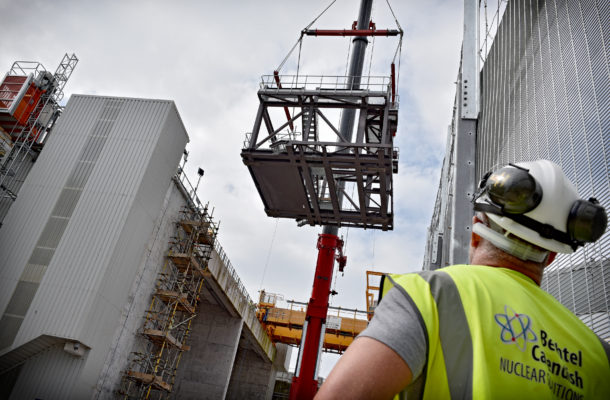Features
4iP Council speaks to Alex Smith, Intellectual Property Manager at the UK’s nuclear reprocessing and decommissioning site, Sellafield
20 October 2016
Innovating by necessity and the significance of patents, in an environment which calls for innovation and adaption of technologies for application in testing and sometimes unique circumstances.
Sellafield is a nuclear fuel reprocessing and decommissioning site, close to the village of Seascale on the Irish Sea coast of Cumbria, England. Alex Smith, head of Intellectual Property at Sellafield Ltd[1] explains how Sellafield achieves technology evolution both itself and through its supply chain and the effect of the patent system on this.

The Sellafield site measures 6 sq kilometres
What innovation takes place at Sellafield?
The focus of much of our development activity is on legacy nuclear waste management, which we conduct on behalf of the UK’s Nuclear Decommissioning Authority (NDA). The NDA owns 14 nuclear sites across the UK which contain redundant nuclear facilities, of which Sellafield is by far the largest. Much of our work is associated with a legacy of materials and redundant plants dating back to the 1940s and 50s. Our innovation relates to our approach to this.
Areas of technical and scientific focus include robotics, remote access technologies, decontamination, effluent treatment and radioactive waste encapsulation. Breakthrough innovations developed here have enabled us to manage our work more effectively, for example in clean-up processes for redundant nuclear waste treatment plants. We don’t generally patent as the focus of our work relates to work here at Sellafield and other NDA sites in the UK, rather than in commercial exploitation, particularly as in some cases the work relates to situations that are specific to us. An example of this would be work on dissolution processes for redundant plants that have processed waste streams unique to us. The NDA therefore holds only a small patent portfolio.
In terms of IP (and specifically patents) we are generally more interested in acquiring access to technology and on freedom to use matters than in seeking protection for innovations for commercial exploitation. Much of my work relates to the contractual aspects of securing such access.
Do patents help?
Restrictions placed by patents are a bit like taxes; they impose an obligation upon us, but in the absence of such a regime, the systems that produce the things we depend upon would not function.
Alex Smith, Head of Intellectual Property
at Sellafield Ltd on the patent system.
As primarily a user of technology, would you support a weaker patent system?
No, I would not. While this might be perceived as helpful in the immediate term, being pragmatic, it wouldn’t work in the longer term because of the negative effect it would have on R&D investment. Restrictions placed by patents are a bit like taxes; they impose an obligation on us, but in the absence of this the result would be a failure of the systems that drive innovation. I therefore don’t perceive the weakening of the patent system to be a credible solution.
Another strong reason for supporting the patent system is the fact that it creates a repository of knowledge. The publishing of information in return for monopoly rights is a fundamental principle of the patent system dating back to renaissance Europe and indeed even to the classical world, depending on your beliefs in the origin of the patent system.

What are the disadvantages of the patent system in your view?
We have a requirement to avoid inadvertent infringement, and we require our technology suppliers to avoid patent infringement and on that basis patent applications at the pre-publication stage are a potential problem. I also have a concern about the increasing use of US style patent trolling by non-practising entities. This is an unhealthy trend.
What do you think inspires invention and innovation?
Necessity is the mother of invention and its modern day twin, innovation. In our environment it is the perception of the problem that drives the innovation. Innovation can mean new processes per se, but can also be the adaption or use of existing technology from other fields. For this reason, we are very open about our technology needs, to the extent of formally publishing them in order to guide the supply chain and to attract ‘new to us’ ideas for solutions.
Are there barriers to innovation?
As a contractor working for a public body, Sellafield Ltd’s activities are required to be consistent with public procurement legislation (in the UK the Public Contracts Regulations (2015) , interpreting the EU Public Contracts Directive (2014)). Engaging contractors to adopt, modify and further develop existing technology must therefore be achieved in a manner consistent with the fundamental European Treaty principles of freedom to provide services, equal treatment and transparency, as cited in the recitals to the Directive. This can present difficulties in our situation where there is substantial background IP owned by a supplier. Often the solution is to issue an output based specification to the market, soliciting offers of technology to meet defined requirements, rather than sponsoring the development of a specific, known offering.
One route through which we access and fund innovation is through pooled development work, partnering with different bodies; industrial and academic. Each partner will have differing needs. Often one partner will want to patent and this is usually fine for us as long as our access to the technology is ensured.
How do you achieve access to background IP given funding restrictions and the fact you do not own much IP?
As we have been discussing, our main interest is in achieving access to technology. For that reason, if we fund development work, either solely or as part of a group, it is essential to us that we are able to exploit the results of the work; outright ownership and/or exclusive rights are in many cases a secondary matter. An important element to this is ensuring that we will have access to any background IP that this may entail. Parties can in some circumstances be reluctant to grant access, sometimes because they wish to negotiate rights at a later stage and sometimes because they are uncertain of their rights to onward license in this regard (possibly due to obligations owed to other parties). Whilst it can be unreasonable for us to necessarily require free access to such background IP, it is essential that terms are agreed and access is underpinned prior to initiation of the work. Plainly, entering into a contract for development without certainty of the background rights that we require for exploitation is not a viable business proposition.
Universities can be optimistic in their expectations on IP topics. We are frequently presented with proposed contractual terms that expect us to pay license fees for technologies that we have funded, or which are dependent upon background rights owned or controlled by the university itself. This represents a problem of understanding of business practices; there is no point in us as an industrial body participating in development work unless we can be confident that we can exploit the results on defined, reasonable terms.
Necessity brings about the need for invention.
In our environment, it is the perception of the problem that drives the innovation.
Alex Smith, IP Manager at Sellafield Limited
One point that often emerges in the establishment of a partnership for technology development is the matter of what contribution we will make to the costs of patent protection of the results of the work. As we don’t necessarily need to patent, our involvement in formal IP protection is a matter that needs to be resolved at an early stage of the partnership. Agreement needs to be reached on the contribution the various parties will make to payments for patent registration and prosecution, the territories of interest and also the support to be provided to litigation in the event of one of the parties requiring to defend the patent or pursue infringement.
What changes would you like to see in the patent system?
I believe abuse of the system is encouraged when claims are very broad and deviate from the core matter of the patent and would therefore welcome more scrutiny of patent quality and vigilance over spurious additions to the core matter of the invention. I am aware of instances where claims have been granted where there is very little ‘inventive step’ justification and if I were to propose a change it would be to encourage stricter review of this at the examination stage.
I also support a wider understanding of the fact that patenting supports an economic need. This is particularly well illustrated by the pharmaceutical industry where profits from the success of one product are reinvested in further innovation.
Author: Emma Bluck
The views expressed in this feature are those of the interviewee and may not reflect the views of 4iP Council or its members. The purpose of this feature area is to reflect thinking on the topic of intellectual property and enable open discussion.
[1] Sellafield Limited has been contracted by the UK Government’s Nuclear Decommissioning Authority (NDA) to run the Sellafield site.



